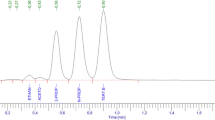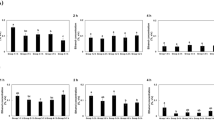Summary
Three-day pretreatment of rats with a daily dose of 80 mg/kg phenobarbital sodium i.p. and subsequent 8-hour exposure to 20 or 200 ppm CS2, followed by a narcotic dose of 100 mg/kg hexobarbital sodium i.p., did not cause appreciable fat accumulation in the liver cells, SGOT and SGPT also remaining normal. Fat accumulation also was absent when exposure to 200 ppm CS2 (48 hrs and 7 days, respectively) was preceded by hexobarbital treatment. By contrast, extensive accumulation of fat in the Kupffer cells as well as in the centrilobular, intermediate and acino-peripheral hepatic areas was found in phenobarbital-pretreated rats 24 hrs after oral administration of a very high CS2 dose of 1 ml/kg in 1 ml/kg olive oil. At the same time, SGOT and the esterified fatty acids in the liver were raised. Accumulation of fat in the liver cells was less extensive in rats not having received phenobarbital pretreatment. Administration of olive oil alone remained without effect. From the results obtained it is concluded that degenerative hepatic damage (e.g. fat accumulation or necroses) is not likely to develop in individuals without hepatic disease receiving barbiturate-containing drug therapy, who at the workplace are exposed to a concentration of 20 ppm CS2 (maximum acceptable concentration, threshold limit value), with occasional peak concentrations around 200 ppm.
Similar content being viewed by others
References
Bond, E. J., Butler, W. H., De Matteis, F., Barnes, J. M.: Effects of carbon disulphide on the liver of rats. Brit. J. industr. Med.26, 335 (1969)
Freundt, K. J., Dreher, W.: Inhibition of drug metabolism by small concentrations of carbon disulflde. Naunyn-Schmiedebergs Arch. Pharmak. exp. Path.263, 208 (1969)
Freundt, K. J., Kuttner, P.: Oxidative drug metabolism following low carbon disulfide concentrations. Naunyn-Schmiedebergs Arch. Pharmak.264, 232 (1969)
Freundt, K. J., Schauenburg, K.-J., Eichhorn, P.: Arch. Toxikol. (in preparation)
Freundt, K. J., Schnapp, E.: Distribution and elimination of carbon disulfide in rats following inhalation. Naunyn-Schmiedebergs Arch. Pharmak.266, 324 (1970)
Kürzinger, R., Freundt, K. J.: Changes in hepatic functions following exposure to low carbon disulfide levels. Naunyn-Schmiedebergs Arch. Pharmak.264, 261 (1969)
Mack, T., Freundt, K. J.: Inhibition of aminopyrine demethylation following inhalation of low doses of carbon disulfide in humans. Naunyn-Schmiedebergs Arch. Pharmak.270, Suppl. R 93 (1971)
Massmann, W., Strenge, K.: Beitrag zur Bestimmung von Schwefelkohlenstoff im Blut. Arch. Toxikol.16, 58 (1957)
Romeis, B.: Mikroskopische Technik, 16. Aufl. München-Wien: Oldenbourg 1968
Author information
Authors and Affiliations
Rights and permissions
About this article
Cite this article
Freundt, K.J., Liebaldt, G.P. & Sieber, K.H.M. Effect of barbiturates on the liver of rats exposed to carbon disulphide vapour. Int. Arch. Arbeitsmed 32, 297–303 (1974). https://doi.org/10.1007/BF02178968
Received:
Accepted:
Issue Date:
DOI: https://doi.org/10.1007/BF02178968




